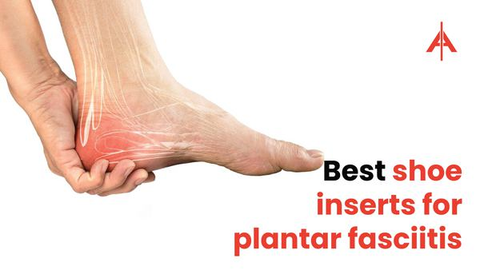Best Shoe Inserts For Plantar Fasciitis

In this comprehensive guide, we delve into the world of plantar fasciitis and explore the best shoe inserts to help alleviate pain and enhance comfort for those suffering from this condition. Plantar fasciitis is a common foot ailment characterized by inflammation of the plantar fascia, a thick band of tissue that runs across the bottom of the foot, connecting the heel bone to the toes. It often results in stabbing pain near the heel, particularly upon taking the first steps in the morning or after prolonged periods of rest. With the right shoe inserts, individuals can find relief from this discomfort and regain mobility without hindrance.
What is Plantar Fasciitis?
Plantar fasciitis is a prevalent foot condition caused by strain and inflammation of the plantar fascia, resulting in heel pain and discomfort.
The importance of addressing plantar fasciitis lies in its ability to impact daily activities and quality of life. Chronic pain and discomfort can hinder mobility and lead to secondary issues if left untreated.
Types and Categories
Types of Shoe Inserts
- Arch Supports: Designed to provide additional support to the arch of the foot, reducing strain on the plantar fascia.
- Heel Cups: Cushioned inserts that cradle the heel, absorbing shock and reducing pressure on the affected area.
- Orthotic Insoles: Customized inserts that conform to the unique shape of the wearer's foot, offering personalized support and alignment.
Symptoms and Signs
Common Symptoms of Plantar Fasciitis
- Heel Pain: Most notable upon waking or after periods of rest.
- Stiffness: Difficulty flexing the foot, especially in the morning.
- Tenderness: Sensitivity or discomfort along the bottom of the foot, particularly near the heel.
Uncommon Signs to Watch For
- Radiating Pain: Pain that extends beyond the heel and into the arch or toes.
- Swelling: Inflammation of the affected area, often accompanied by redness.
Causes and Risk Factors
Biological Factors
- Foot Mechanics: Flat feet or high arches can contribute to improper weight distribution and increased strain on the plantar fascia.
- Age: Middle-aged individuals are more prone to developing plantar fasciitis due to natural wear and tear on the foot.
Environmental Factors
- Occupational Hazards: Jobs that require prolonged standing or walking on hard surfaces can increase the risk of developing plantar fasciitis.
- Improper Footwear: Wearing shoes with inadequate support or cushioning can exacerbate symptoms.
Lifestyle Factors
- Physical Activity: Overuse or sudden increase in activity levels, such as running or jumping, can strain the plantar fascia.
- Obesity: Excess weight puts added pressure on the feet, increasing the likelihood of developing plantar fasciitis.
Diagnosis and Tests
Common Diagnostic Tools
- Physical Examination: Assessment of symptoms and range of motion.
- X-rays: Imaging to rule out other potential causes of heel pain, such as fractures or bone spurs.
- Ultrasound: Visualization of soft tissue to detect inflammation or tears in the plantar fascia.
Treatment Options
Medical Treatments
- Rest and Ice: Resting the foot and applying ice packs can help reduce inflammation and alleviate pain.
- Physical Therapy: Stretching and strengthening exercises to improve flexibility and support.
- Medications: Nonsteroidal anti-inflammatory drugs (NSAIDs) to manage pain and reduce inflammation.
Therapies
- Shockwave Therapy: High-energy shockwaves to stimulate healing and tissue regeneration.
- Corticosteroid Injections: Anti-inflammatory medication injected directly into the affected area for rapid relief.
Lifestyle Adjustments
- Footwear Modification: Switching to supportive shoes with cushioned inserts to alleviate pressure on the plantar fascia.
- Orthotic Devices: Customized shoe inserts designed to provide targeted support and alignment.
Preventive Measures
Tips for Prevention
- Stretching Exercises: Regular stretching of the calf muscles and Achilles tendon can help prevent strain on the plantar fascia.
- Gradual Progression: Avoid sudden increases in activity intensity or duration to minimize the risk of overuse injuries.
- Proper Footwear: Invest in supportive shoes with adequate cushioning and arch support to maintain proper foot alignment.
Personal Stories or Case Studies
Real-Life Implications
Sarah's Story: Sarah, an avid runner, struggled with persistent heel pain that threatened to sideline her from her favorite hobby. After consulting with a podiatrist and investing in customized orthotic inserts, she was able to resume her training regimen pain-free.
Expert Insights
Quotes from Medical Professionals
"Proper footwear and supportive shoe inserts play a crucial role in managing plantar fasciitis and preventing recurrence." - Dr. Emily Chen, Podiatrist
Conclusion
In conclusion, finding the right shoe inserts for plantar fasciitis can make a significant difference in managing symptoms and improving overall comfort. By addressing the underlying biomechanical issues and providing targeted support, individuals can alleviate pain and regain mobility without disruption to their daily lives.
















